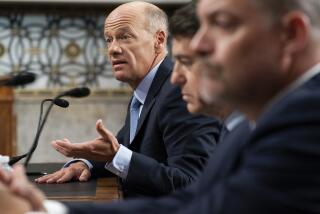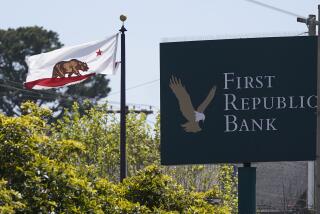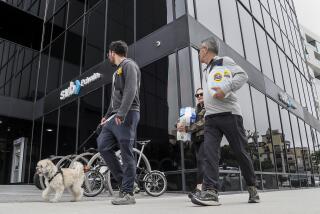Needed: a Strategy for Insolvent S&Ls; : Even With Bail-Out, Little Is Being Done to Curb Excess Risk-Taking
- Share via
Most of us are depositors in savings-and-loans, and we are taxpayers.
As depositors, we can switch deposits from solvent S&Ls; to insolvent ones, where we can earn as much as 2.5 percentage points more on our deposits. With a balance of $100,000 or less, the deposits will also be guaranteed by the Federal Savings and Loan Insurance Corp. Insolvent S&Ls;, now estimated to number 450, pay higher rates primarily as part of a gamble for resurrection. Resurrection requires taking higher risks. To fund the higher risks, insolvent S&Ls; use higher deposit rates to lure depositors from solvent S&Ls;, banks and other financial institutions.
As taxpayers, however, we are ultimately liable for the losses that are embedded in the portfolios of the high-rate-paying insolvent S&Ls.; Until now, when the FSLIC closed an insolvent S&L; it paid the difference between the value of the insured deposits and the lower value of the S&L;’s assets. But the FSLIC is now more than $6 billion in the red. The FSLIC exhausted its reserve by having to close more than 600 S&Ls; since 1980--an unprecedented number--many of which were extremely costly. On Monday, President Reagan signed a measure that requires surviving S&Ls; to recapitalize the FSLIC with $10.8 billion. Congress originally wanted to give $8.5 billion. But the President, who asked for $15 billion, threatened a veto.
In 1985 we estimated that the cost to close the insolvent S&Ls; would be approximately $16 billion. In 1986 the Federal Home Loan Bank Board, the country’s primary S&L; regulator and the operating head of the FSLIC, estimated that the cost would be $16 billion to $23 billion. Others put the cost as high as $45 billion.
In 1986 we also wrote that the cost was growing at $1 billion per year, based on 229 insolvent and unprofitable S&Ls; in 1985. In 1986 the number of insolvent and unprofitable S&Ls; rose to 327. As a result, some analysts believe that the costs are rising at a yearly rate of $2.5 billion to $4.5 billion.
Because of accounting practices, the cost to close insolvent S&Ls; could approach the higher estimates. Industry net worth and profits are inflated, for example, because regulatory accounting principals allow S&Ls; to record gains on assets sold but do not require unsold assets whose value has declined to be marked to their market value. Because of these kinds of gimmicks, hundreds of apparently solvent S&Ls; are probably insolvent.
The bank board restrains risk-taking primarily through examinations, supervision and enforcement. In 1985, as insolvencies rose, the number of examiners declined. Although the number of examiners and other personnel is increasing, the risk-containment mechanism is still thoroughly strained.
The solution to the problem of several hundred open and insolvent S&Ls; depends on finding the appropriate amount of funds to pay insured depositors when institutions are liquidated or sold by the FSLIC. Existing S&Ls; are a poor source of funds (they earned profits of only $400 million in 1986, and current earnings suggest a profit of only $600 million in 1987).
Whether surviving S&Ls; have an obligation to pay for insolvent S&Ls; is also a legitimate issue. Beyond its regular insurance premium, a surviving S&L; probably does not have a responsibility to pay for another S&L;’s failure. To the extent that surviving S&Ls; have argued for regulatory forebearance that prolonged the closing of insolvent S&Ls;, they deserve to pay for part but not all of the cost.
As a result, a commitment of taxpayers’ dollars will be required. Congress needs to commit general revenues to allow the board to develop a program to close insolvent S&Ls; over several years’ time.
A massive triage mechanism is needed. An army of examiners, supervisors, lawyers, accountants and more needs to be conscripted to control the risk-taking of insolvent S&Ls; that will be closed.
Congress would also be wise to place the full faith and credit of the United States behind the FSLIC as soon as possible. Most Americans are unaware that no congressional guarantee backs the corporation. Without such a guarantee, a relatively straightforward problem of cost could under some circumstances become a more complicated problem of stability for depository institutions.
As depositors, you can move insured deposits into high-rate-paying insolvent S&Ls.; You can thank Congress, the Administration and the bank board for keeping the S&Ls; open for your higher-earning deposits. As a taxpayer, you should be incensed that the opportunity exists, because you are going to pay for those high rates when Congress gets around to sending you the bill for the escalating cost of the S&L; insolvency.
More to Read
Inside the business of entertainment
The Wide Shot brings you news, analysis and insights on everything from streaming wars to production — and what it all means for the future.
You may occasionally receive promotional content from the Los Angeles Times.










